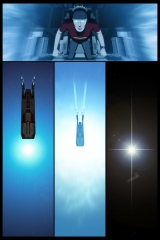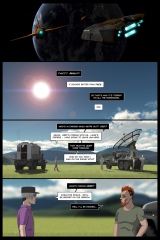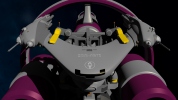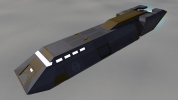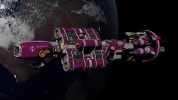Celebrating leap day with a new page – one that’s fairly significant, both for the amount of work involved and the amount of work that has been saved. In late 2014 I decided I was going to throw everything at the wall with this chapter – instead of being the planned journey through a couple of major plot points, Fire was, I decided, going to jam as much plot into as few pages as possible. In the process of boiling things down I managed to cut what had been planned as an entire book of the series into a handful of carefully positioned scenes. This page and the next are the first; the next is a few pages after and the third is planned as part of the next installment. This optimization cut the theoretical workload of a major plot point down from a book-sized design project to an actual workload of four new – or nearly new – spacecraft, eliminating the need for the development of new interiors, characters, and environments in the process.
There are five models of spacecraft on this page. Two of them are cameos – they appear on this page and this page alone, though they are fully realized vehicles fit to be utilized as assets in any future work. Just about, anyway – I knew in advance roughly what I’d be doing for layouts, roughly what shots I wanted and roughly what sort of distances I’d be dealing with so I decided that the new ships would not be textured. The maps on the new vehicles are decals only, in the style of model airplanes. This optimization saved an enormous amount of development time, and at webscale it’s barely noticeable – compare the Pollux to a similar shot of the Castores and you’ll see what I mean – the Castores has hull maps, the Pollux does not. I damned near committed to adding them when I was checking over the model prior to rendering and if I had I’d probably still be working on the page, or fulminating neurotically into the void, or both. Fortunately I checked myself before I wrecked myself and spent that work session working on lighting and shot composition. I’d like to think that the results speak for themselves. :D
Speaking of speaking, the characteristically chatty crew of the Cheops is uncharacteristically quiet. This is almost entirely for aesthetic reasons – I think the page looks great without dialogue. I don’t think it needs any. Words would detract from the tasty color scheme of the Pollux.
Spacecraft, in order of appearance:
- The Cheops – A Titan class satellite tender and picket ship. Earth’s only line of defense. It can – or could – separate, and it’s been missing its top half since September of 2006.
- The Pollux, sister ship of the Foundation class Castores. Key features include a slightly longer nose, some additions to the rotating section, upgraded engines, a synthetic FTL system and a pair of Titan servicing and transport mounts.
- The Atlas – A Titan mark IX riding on the back of the Pollux. A much newer design than the Cheops, complete with railguns, servicing bay, and a rough internal deck plan.
- A pair of Valkyrie escort fighters appear in panel four – they’re tiny little smears of pixels at webscale. If you want a better look at the design you can check out this blog post – or you can wait for the next page, which – spoilers! – features a spiffy bit of engine porn!
- The Oberon appears below the Valkyries. It also appears on the next page and again later in the chapter. A Javelin class transport, the Oberon is a palette-swap of the Daedalus.
The Foundation class flight deck ultimately determined the layout of this scene. From any “over the shoulder” angle the flight deck can be safely implied; shot from the front it would have to be modeled, which would have been a lot of work for only one or two shots.
The Oberon took the least amount of time to develop; the Atlas the most. The Pollux kinda felt like it took forever but some of that blends in with the initial construction work done on the Castores, as well as transitional work to strip off textures, redo detailing, fix scaling issues, etc. The Valkyrie was probably the most fun of the batch. It looks good on the next page, which will probably be up around this time next week. While that one is technically interesting it’s not nearly as significant as this page so there’s no rush to finish it, and certainly no need for it to crowd the leap day spotlight!

